A good spotting scope tripod is vital if you’re going to be using one of these powerful scopes for hunting or just general target shooting.
Tracking a target with such a high-magnification scope is very difficult (if not downright impossible) without a tripod to help keep you steady and allow you to lock in a position. And you can forget reading the wind reliably without one.
So here are the best spotting scope tripods to help you out.
Table Of Contents
Our Best Spotting Scope Tripods
- Vortex Optics Pro GT Tripod (Our Top Pick)
- Carson TriForce Series (Best Budget)
- Manfrotto MT190CXPRO4 Carbon Fiber 4-Section Tripod (Best High End)
- Bushnell 784030 Advanced Tripod
- RetiCAM Tabletop Tripod
What Are Spotting Scope Tripods?

Much like a camera, a spotting scope really needs a good tripod for stability. These three-legged platforms hold your scope (or camera) steady so that you can take accurate range measurements, spot targets, and track animals when hunting or birdwatching.
Essentially, these three legs give you the same stability you would get on a long-range rifle equipped with a bipod at the front and monopod at the rear.
There are a few different types of tripods as well as head types that dictate how you can move the scope around once it’s mounted. Beyond that you’ll need to consider things like build quality and materials, as well as weight and size.
What Are The Different Types Of Spotting Scope Tripods?
There are three main types of spotting scope tripod: tabletop, compact, and full-size.
Tabletop Tripods

Tabletop tripods are small and are designed to be used on a shooting table or other similar surface. These are good if you’re going to be shooting primarily off a bench with a spotter, or if you’re looking to keep a hunting setup light and easy to move with.
These are also generally going to be your most lightweight tripod option, as well as the cheapest, though they can get expensive as well. Price tag aside, these are a great option for serious bench rest shooters.
Compact Tripods

Next, we have compact tripods which are a little bit bigger, but generally too tall to be used in the prone or when seated at a bench, but they’re perfect if you’re sitting up or in a chair.
These compact models fold up relatively small and fit well in a pack, making them extremely popular with backcountry hunters and backpackers.
Compact models tend to trade a little of the portability of a tabletop model for a little more sturdiness, making them great for larger and heavier scopes with an objective lens of more than 70mm. They do have a taller minimum height though so using these on a shooting bench is tricky.
Full-Size Tripods
Meanwhile, a full-size tripod is larger and can be challenging to transport, but they typically are more heavy-duty with a higher load capacity and extra sturdy legs. This is where you’ll find most of your carbon fiber tripods.
And of course, these can all be used while standing up, making them great for long-range target shooting if you have a spotter or for birding.
A full-size tripod has the greatest maximum height so if you just don’t want to be all hunched over when spotting, this is a great option. You just may want to grab a carrying case off Amazon to help you lug it around. Even with aluminum tripod legs, these things can get heavy.
The largest of these can extend to as much as 65” when the center column is locked at full extension so you should have no problem finding a comfortable viewing height even if you’re an NBA player.
Whatever type of tripod you use though, they all work basically the same way. The primary differences are in the height range and the tripod head type.
How Do Spotting Scope Tripods Work?
Simply put, a good tripod holds your spotting scope steady while leaving your hands and arms relatively free to aim the scope and make adjustments without having to worry about supporting the weight and position of the scope all on your own.
The basic design is three adjustable legs (hence “tri”-pod) attached to a central column and topped with a tripod head. You can change the leg angle to adjust the overall height of the tripod head.
Speaking of tripod heads, there are three types you need to really be aware of.
First, there is the pan head (also called a tilt head) which moves in two directions, usually left to right and up/down. These are the most useful for spotting scopes that are going to be used on relatively even ground such as a flat range or shooting bench.
Then there’s the ball head which has a ball-and-socket joint that allows a 3-way pan, essentially letting you position the scope or camera however you want. These are great if you are forced to set up on a bit of an angle such as on a ridge while you’re hunting.
If you’re going into the woods after wild game, a ball head and maybe a bubble level are good investments. For birdwatching or digiscoping, a pan/tilt model is probably more than enough.
Finally, you have things like fluid heads that have settings for how fast you can go about panning or tilting, but these are pricey and are designed for camcorders shooting video. Not the best for a spotting scope, though they will work. You don’t really need a fluid pan head for glassing a field or calling wind though.
Oh, you also have different types of locking mechanisms such as twist locks, flip-lock lever locks, and even pistol grips with triggers, but this mostly comes down to preference and budget.
All of them will hold the scope steady when locked and unlock fairly easily.
However, the faster flip-lock and pistol grip options are generally better for field use, but twist locks are fine for range use or just when you know you’re going to be in a fixed position for a while.
Whatever you go with for your head and leg locks, there are few things every good tripod should have.
What Do You Look For In The Best Tripods For Spotting Scopes?
These are the things you want to be on the lookout for when choosing a good tripod.
Materials
Carbon fiber is lighter but more expensive. Aluminum legs are cheaper but heavier. Which one do you need? Are you setting up on a bench and not moving for a few hours? Aluminum is probably the way to go.
Are you trekking through the backcountry for days at a time in a situation where every ounce counts? Carbon fiber may be worth the extra price.
Stability
If your scope won’t stay still and has a bad wobble, you’re going to have a really frustrating time using your tripod. Make sure your tripod’s legs are sturdy enough for the scope you’re using and make sure the rubber feet (or spiked feet) are high-quality and will provide good traction.
Quick Release
We highly recommend a tripod that comes with a quick-release plate. This is an excellent addon for your tripod kit that allows you to quickly and easily remove your scope from the tripod for storage.
Best Spotting Scope Tripods Reviewed
We reviewed several dozen tripods in our quest to find the best ones for use with a spotting scope. These are the ones that rose to the top of the heap.
1. Vortex Optics Pro GT Tripod (Our Top Pick)
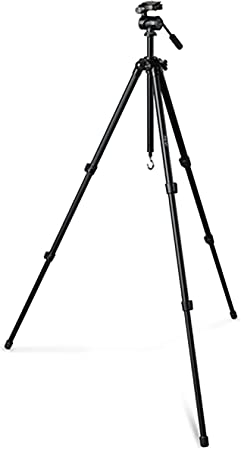
Our top pick comes from an optics manufacturer. The Vortex Optics Pro GT Tripod is robust enough to survive being carried over rough terrain by hunters and the most dedicated of birdwatchers, but still relatively light.
The three-way panning head moves smoothly and locks into place easily and the tripod itself can hold up to a ten-pound scope which is more than enough for anything shy of a full-on telescope. For most normal spotting scopes, this is an excellent pick and will do great in the field or at the range.
Pros
- Good height range
- Excellent construction
- Easily-adjusted
Cons
- Rubber feet don’t articulate
- A little heavy compared to carbon fiber options
Buy The Vortex Optics Pro GT Tripod On Amazon
2. Carson TriForce Series (Best Budget)
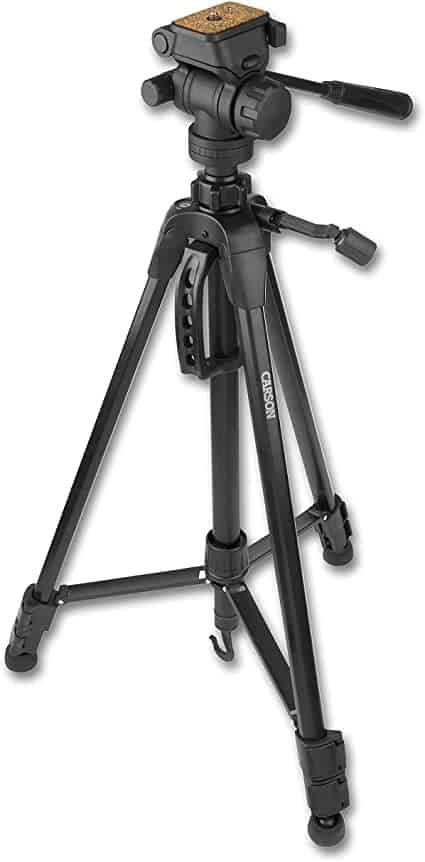
Carson makes a number of budget-friendly outdoor and shooting sports products, and their Triforce Series tripods certainly fit in well with that lineup. These affordable tripods are a great choice for casual users that aren’t going to be beating up their tripod too much in the field.
For sitting in a hunting chair at the range calling wind and marking hits for your buddies plinking at steel at long range, this is a really great option that won’t break the bank.
It’s not as stable or as robust as some options, but it does the job and you won’t need to worry too much about the cost.
Pros
- Affordable
- Lightweight
- Lever-lock head available
Cons
- Not as stable
- Heavy for what it is
Buy The Carson TriForce Series On Amazon
3. Manfrotto MT190CXPRO4 Carbon Fiber 4-Section Tripod (Best High End)
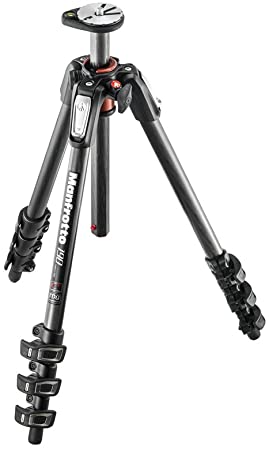
On the opposite end, we have the Manfrotto MT190CXPRO4 in carbon fiber. Make no mistake, this thing is pricey. This is in the realm of what we would call “professional grade”. If you’re looking for the best possible option (lightweight, sturdy, excellent head, and controls) this is the one.
This is the type of thing a safari guide would have for their spotting scope or a pro shooter who is reading the wind before shooting a precision rifle competition stage. It is far from cheap, but the carbon fiber construction makes it light enough for an intrepid trail seeker, but still robust enough to handle some abuse.
Pros
- Top-tier construction
- Lightweight
- Incredibly easy to use
Cons
- Expensive
Buy The Manfrotto Carbon Fiber 4-Section Tripod On Amazon
4. Bushnell 784030 Advanced Tripod
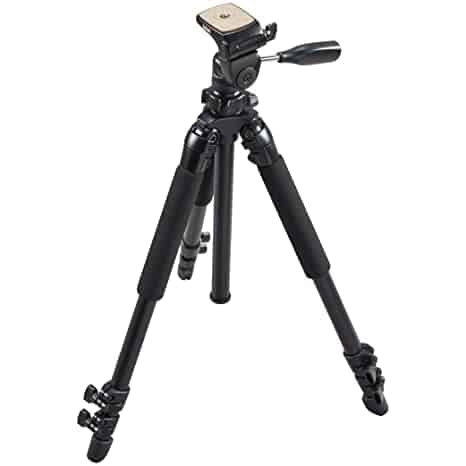
Bushnell is another company known for its optics so it makes sense that they would have a good tripod as well. This one edged out the Vanguard Alta Pro and Celestron models as a good choice that is a little more robust than the strictly budget models, but still cheaper than the Vortex option.
It has foam leg covers to keep them from getting beaten up too badly, and the twist-lock on the head is easy to use even with gloves on so adjustments are straightforward. It’s also very lightweight and easy to transport, making it a good all-around option.
Pros
- Padded legs
- Excellent pan/tilt
- Easy to use
Cons
- Not as robust as some
- Rubber feet can slide on sloped terrain
Buy The Bushnell Advanced Tripod On Amazon
5. RetiCAM Tabletop Tripod
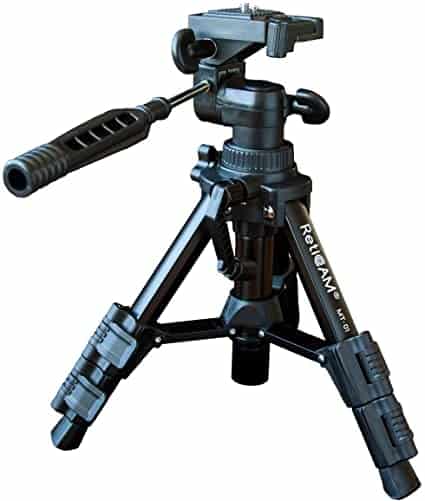
Finally, we have our tabletop pick, the RetiCAM Tabletop Tripod. This one has a nice three-way pan head with twist locks and a nice handle for making fine adjustments. The overall height is perfect for shooting from a bench or table, and it’s light and compact enough that you can check your own hits and misses if you don’t have a spotter.
On top of that, it makes a great addition to a range bag just because it collapses down so small (about the size of a Nalgene) so you can throw it in a pack or bag and forget about it until you need it.
Pros
- Compact
- Stable
- Affordable
Cons
- Low max-height
- Really needs to be used with a table
- Not very sturdy when used with heavy scopes
Buy The RetiCAM Tabletop Tripod On Amazon
Final Thoughts On Tripods For Spotting Scopes
That’s about all we have on tripods for spotting scopes. Hopefully, this helped make the task of choosing your very own tripod a little easier and you now know which one you need to pick.
All of them are great options, but at the end of the day, you have to decide which one meets your specific needs the best.
